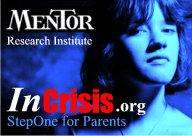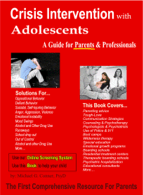By: Michael Conner, Psy.D Summary
The use of force and restraint is a legitimate tool in health care and public service roles that are responsible to maintain order, protect lives and insure public safety. Organizations that perform these functions in society are highly regulated and staffed by licensed or certified professionals such as police officers or doctors. Wilderness programs are not fully regulated and many are not licensed. The role of licensed professionals within wilderness programs vary greatly. Ethical and professional standards of practice, including responsibility and liability for students' well-being, are higher for professionals than unlicensed employees. Licensed and certified programs have a higher level of accountability than unlicensed and uncertified programs. Program policy and procedures are essential in society to hold organizations and programs accountable. Professionals and program managers have a civil, contractual, ethical and moral responsibility to protect the lives and rights of their students. There must be clear lines of authority and responsibility for the use of restraint or force in any program where employees presume to have the authority and responsibility of parents or legal guardians. Non-professional wilderness therapy staff have less authority to use force and restraint than parents, physicians and law enforcement. Wilderness therapy programs do not have the same disciplinary prerogatives and authority as parents. Wilderness Therapy vs. Boot Camp Programs Before exploring the use of force in detail, a distinction must be drawn between a "wilderness therapy program" and a "juvenile boot camp program". Wilderness therapy should not be confused with a juvenile boot camp program. The philosophy of wilderness therapy is to allow children to experience the force of nature as their teacher and to avoid staff use of force and restraint. Boot camp programs are designed and run with a high degree of interpersonal confrontation as well as physical and psychological aggression toward students. Wilderness therapy programs are designed to create therapeutic opportunities and choices when students are confronted with nature and inevitable realities when living in a primitive environment. The fact that a student must gather wood and build a fire in order to cook (i.e. wilderness therapy) is different than screaming and intimidating a child if they don't do what they are told (i.e. a boot camp). Obtaining control and compliance through the use of intimidation and coercion is characteristic of a boot camp program. Wilderness therapy and boot camps are distinctly different and incompatible approaches to working with youth. Justification For The Use Of Force The public is rightfully concerned with the use of force or restraint in society. Use of force or restraint may be necessary in the following roles
There is little question that wilderness therapy guides and instructors may face oppositional, self-destructive and sometimes violent students. Students may bring histories of threatening and destructive behavior. However, employees in wilderness programs must legally and professionally articulate the basis of their actions when dealing with students - especially when staff claim that a student was acting in an unsafe or dangerous manner. There are three critical questions at the heart of this issue.
The answers to these questions are critical to managing personal and program liability, safeguarding a child's health and emotional well-being, and ensuring that an employee's career and life is not ruined. When employees in wilderness programs do not answer these questions, public opinions are formed on the basis of appearances and incomplete information. Potentially successful programs can end up failing students. Criminal charges as well as civil suites against employees and programs can ensue. The actual cause of injury is not necessarily limited to the staff who took action. Responsibility and accountability may rest with program managers and supervisors. Standards Of Practice In The Use Of Force And RestraintI have been employed to provide services, consultation and training in law enforcement, emergency rooms, medical hospitals, psychiatric hospitals, residential treatment programs and the airline industry. In each of these professional settings I have received training in the use of force and restraint as well as education regarding the personal, professional and legal consequences for the misuse of that authority. I have also been involved in the use of force, as well as crafting alternatives and training in the use of force and restraint. I am currently working with an airline to develop their policies and training to deal with "air rage". In each of these settings there are standards of practice as well as procedures that are normally dictated by program procedures, public policy or professional consensus. In addition to the most typical settings where violence erupts, I have worked intensively with two wilderness therapy programs. For almost a year I have monitored the activities of 39 wilderness therapy programs programs nationally. I am no longer affiliated with any wilderness programs. Wilderness programs have less uniform standards when compared to residential and medical settings. The use of force and restraint must be necessary and justified. More importantly, licensed professionals are expected to act with compassion and to consider alternatives as well as less dangerous or restrictive alternatives whenever possible. Law Enforcement and Corrections. The behavior of law enforcement falls within the highest legal scrutiny and enforceable consideration of an individual's civil rights. Law enforcement can only restrain or use that level of force necessary to address a clear and immediate danger, insure the safety of citizens, or that level of force that is necessary to enforce public policy, the law or legally authorized actions. Police officers cannot use their authority to limit the freedoms of children or adults without a basis in law, department policy and public policy. As a society, we empower law enforcement to maintain order and to enforce certain laws. In prison populations, an inmate's rights and freedoms are limited specifically as a matter of public policy and safety. Inmates rights are limited based upon procedural actions taken within a legal system and judicial process that protects the rights of all citizens. The use of restraint or force by police officers or prison guards are subject to internal reviews, checks and controls by public officials and citizens. There are explicit training, documentation and review procedures available to anyone who believes their rights or the rights of others were violated. Students in a wilderness therapy programs are not automatically prisoners by virtue of their admission, nor are they under arrest. They have the same rights and freedoms as any child. Medical and Mental Health Care. Medical and health care professions are empowered by licensure of their professionals, or statutory and administrative authority granted by government to organizations such as a hospitals and residential treatment programs. The standards of practice and care within these settings are based on improving health and well-being as well as saving and protecting life. Physicians have the authority, within clearly defined professional and public policy, to restrain patients and to use force as a medical necessity to insure safety, protect and save lives. Such actions must be ordered by an authorized treating professional with the same due diligence and responsibility one has if they were providing an emergency surgery. The use of force and restraint without public sanction or a legal basis is a violation of law and raises the matter of our constitutional rights. Just like law enforcement, medical and mental health professionals must be able to articulate, document and defend their actions. They are subject to review procedures available to anyone who believes their rights or the rights of others were violated. At most, children in a wilderness therapy program are patients who have rights. Admission to a wilderness therapy treatment program does not diminish the rights of students. Wilderness Therapy Programs. Many wilderness therapy programs are highly unregulated and lack clear program philosophy. In some programs, it is unclear whether children are treated as children, students, patients or prisoners. Policy and procedures vary tremendously, may not exist, may lack specificity and may not be followed. Unlike professionals in medical and mental health care settings, licensed medical and mental health professionals in wilderness programs may lack the formal responsibility or authority to establish or to enforce reasonable standards of practice. Licensed professionals and ethical responsibility in a wilderness program without program positional authority is a problem in some wilderness therapy programs and many boot camp programs. And while employees in programs may be referred to as counselors, they are not necessarily professionals or truly qualified for their duties. Professionals may or may not be responsible and empowered to supervise all therapeutic activities including the use of force. The use of force and restraint in wilderness programs have become justified as a response to student defiance or a treatment necessity by employees who are untrained, inadequately supervised and unqualified to authorize such actions toward children. The common rationale for the use of force or restraint in a wilderness therapy program is "student safety". This position is analogous to law enforcement's position years ago that the use of force was necessary for "officer safety". When questioned by the public about the reason for a particular use of force, the standard response by law enforcement was "officer safety." But raising the issue of officer safety is really a question, not the answer to a question regarding the use of force. If the reason was officer safety, then there must be a description of "What represented a threat to officer safety?" Law enforcement has increasingly been called upon to define and articulate what constitutes a threat to officer safety. The use of force for "student safety" could mean a student did not do what they were told and that a student's refusal or argument represented some potential danger in the estimation of staff. Evidence and reason are crucial. Merely saying "I used fore force for student safety" is not a justification for the use of force or restraint. The use of force is not justified when a child refuses to stop talking, refuses to hike, refuses to brush their teeth, or won't repeat their "assigned" number every 3 to 5 seconds when they are urinating in private. In sharp contrast, if a student refuses to follow directives when there is a clear and immediate danger, one could be justified in taking steps to protect that child. Certainly there is cause for mild concern when a child refuses to move, return to camp immediately or refuses to eat their dinner, but there are alternatives far less threatening and dangerous than the use of force or restraint. The use of force fosters rapid compliance in behavior through a climate of coercion in which students fear the prospect of punishment, humiliation, loss of relationship, injury or pain. The use of force for behavior modification is a high risk intervention and can result in an escalation of violence. Escorting a child by force and then restraining that child because they choose to struggle against what they considered an assault by staff is not necessarily justified. A student may return force, and even greater force if they are feeling threatened, out of control, helpless, trapped or angry. These are predictable responses from children in these programs that carry tremendous responsibility when force is initiated by staff. Employees in wilderness therapy programs are not legally or professional empowered to use force or restraint by virtue of a program philosophy, a job description or parental permission. The use of force toward others is not a self-appointed authority nor is it an authority that can be transferred from parents or guardians to employees of a program that are not qualified. Training alone does does not mean staff are necessarily qualified. Any use of force or restraint in a wilderness program must constitute a medical, treatment or legal necessity supervised or implemented by a trained and qualified professional. The use of force as a punishment or to gain compliance when there is no immediate danger and no treatment plan is not medically, legally or professionally justified. The role of force in parenting is a decision that should be left to parents who will bear the personal and legal consequence for any abuse. There are alternatives to the use of force in wilderness therapy programs. They are more expensive, sophisticated and labor intensive. Why Do Programs Use Force and Restraint? The use of restraint and force is only justified when such actions are legally and medically justified. Actions taken to stop behavior that represents a clear and immediate risk of harm to self or others is potentially justified. So why do programs use force and restraint when students are merely oppositional, defiant and refuse to comply with program rules and staff directives? Here are some common reasons.
Conclusions The use of force and restraint in a wilderness therapy program is never justified without a qualified professional supervising therapeutic activities. The use of force is more likely in a program where licensed professionals are not officially responsible and lack official authority. The risk of harm, injury or death is high when program management does not appreciate their obligations nor the danger to students when force is used by their employees in service of poorly designed interventions. Policies, procedures and standards for training are necessary. The reason for any use of force or restraint for purposes other than self-defense or protecting others must be based on behavioral, social and clinical science. The use of force and restraint can be used in a wilderness therapy program for self-defense, to insure student safety and to insure the safety of others - and only when there is a clear and immediate danger. Use of force as a "treatment option" or behavioral modification procedure must be the decision of a qualified and authorized professional dealing with a student and on a case-by-case basis. The authority to use force or restraint in programs treating children must also be grounded in some public policy. Licensure and a qualified professional scope of practice that includes a therapeutic use of force should become minimal requirements in wilderness therapy. Employees, instructors and guides in a wilderness program should never be allowed to force compliance from students without the specific order given by a responsible, qualified and licensed professional.
Copyright 2000 to 2011, Michael G. Conner |


